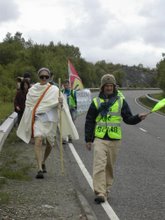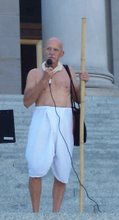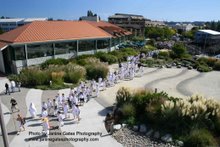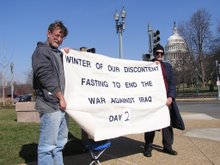I traveled to India from September 23rd to October 14Th and want to report a sense of India from this trip. The trip has two general levels of experience: my itinerary to five cities portraying Gandhi and my observations about the radical changes in India happening at this time.
I was invited to the Youth Peace Festival in Chandigarh from September 27Th to October 1. Here, 500 youth from 10 countries, including Pakistan, Shri Lanka, the Philippines, UK, US, and India, participated in the Festival. I gave the "Inaugural Address" as the American Gandhi and presented the youth with the opportunity to be the change that the world demands today in the light of resource depletion, climate change, nuclear weapons, poverty, and violence. As Gandhi, so they can change themselves to face courageously the realities of today's world.
After the Festival, I traveled to Delhi to participate in first "All India Rally" against nuclear power on October 2ND, Gandhi's 140Th birthday. My Gandhi appearance fit right into the occasion to lead the rally at Raj Ghat (memorial site of Gandhi's cremation) and walk through the streets of Delhi. I connected my anti-nuclear work in the US and UK with that of India.
From October 5Th to 8Th I presented Gandhi in the Rajsamand area under the sponsorship of ANUVRAT at the Children's Peace Palace. We visited numerous schools, universities, and teachers' educational institutions.
On October 10Th and 11Th, I presented Gandhi in Aurangabad with the aide of Dr. Chavan who had invited me originally to India in 2005 to portray Gandhi. Among the appearances was a lively discussion among activists, doctors, scientists about the serious needs of the day. As at the Children's Peace Festival, the escalating shrinkage of water was the dominant topic. Chavan picked up on the "American Gandhi seeking 79 truth seekers" flyer from my book, THE AMERICAN GANDHI, My Seeking Truth With Humanity at the Crossroads." Chavan promised more to come from the encounter.
On October 12Th and 13Th I presented at a university co-initiated by Gandhi in 1920, Gujerat Vijapeeth, which includes a Gandhi Studies Program. Also, I visited for the first time the Sabermati Ashram, Gandhi's second ashram in India and the site of the initiation of the Salt March. My host took me to a village where I experienced a traditional village undergoing changes due to modern developments.
The trip included 23 Gandhi presentations, two public demonstrations: the Anti-nuclear rally and a disarmament walk in Chandigarh; and numerous media interviews among all the interactions with people along the way.
My second level of experience and observation is about the developments within India as she seeks to take her place as a nation and power (superpower). The new creation of superstructure in roads and airports is most obvious everywhere. What is not obvious is the social upheaval to the peoples. Gandhi's India is disappearing, the India of the 700,000 villages. Creations of dams, roads, cities, and superstructure of all forms as India joins the world market economy is pushing the villagers to the cities. On top to this the rampant grabbing of natural resources (water, uranium, bauxite, etc) is taking place in the tribal and village rural areas. I had two personal encounters with persons and groups facing these daunting challenges. Upon entering Delhi at the airport I discovered Arundhati Roy's new book, LISTENING TO GRASSHOPPERS, FIELD NOTES ON DEMOCRACY. Here, she presents a poetic, passionate account of the effects of these developments on the peoples of India, emphasizing the "terrorist" actions of the first decade of the 21st Century. I cannot recommend this book highly enough for those interested in India and the world today. Her sense is that India's options are boiling down to social justice or civil war.
Tuesday, October 20, 2009
Subscribe to:
Posts (Atom)







